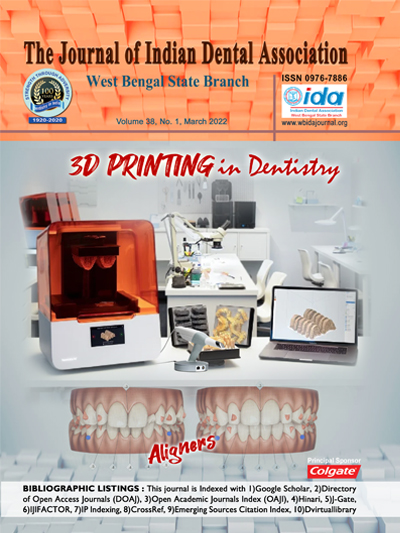Upcoming Events
1. Article Title.
2. Author Details.
3. Abstract.
4. Keywords.
5. Corresponding Author details.
March 2022
Volume : 38
No.: 1

Dr. Atasi Chakraborty,Dr. Soumen Pal,Dr. Mehendi Tirkey Sengupta,Dr. Dulal Das,Dr. Subir Sarkar
Abstract: Abetalipoproteinemia is an autosomal recessive disease resulting from mutations in the gene encoding microsomal triglyceride transfer protein. Affected patients present with a wide range of clinical symptoms during infancy. Typical manifestations are failure to thrive, low level of cholesterol and fat malabsorption. Other features like fatty liver, acanthocytosis and anemia are usually present. Such individuals with compromised immunity may be especially vulnerable to the effects of oral diseases. Children affected with more severe conditions have increased risk of having unmet dental needs. Here we present a rare case report of a 5-year-old male with abetalipoproteinemia with multiple carious teeth managed with behavioural management techniques.
Dr. Mayukh Misra,Dr. Rajarshi Banerjee,Dr. Chirantan Maity,Dr. Ankita Saraf
Abstract: Comminuted mandibular ramal fracture is rarely encountered and there hardly exists any consensus or evidence-based treatment protocol in literature on internal fixation of these fractures. The authors aim to present a case of left sided comminuted mandibular ramal fracture, associated with contralateral parasymphysis fracture, that was treated with Open Reduction and Internal Fixation (ORIF) under GA; with an emphasis on classification of ramal fracture and their fixation protocols
Dr. Sampita Dhali,Dr. Sudipa Meyur,Dr. Arunava Chatterjee,Prof. (Dr.) Amal Kumar Chakrabarti,Dr. Pinaki Roy
Abstract: Class II malocclusion is most common problem around the world affecting 1/3 rd of the patients reported for orthodontic treatment management. Mandibular retrusion is the most prevailing characteristic of Class II malocclusion. In adolescent patient treatment by growth modification is one of the most debated topic and noncompliance is the major concern for orthodontists. This paper discusses the management of 21 year old female patients with Angles Class II Division 1 malocclusion with minimal growth remaining and with mandibular retrognathism who were treated with a two-phase therapy. In first phase alignment of arches with fixed Pre Adjusted Appliance (0.022” MBT) was done followed by a second phase involving application of Forsus fixed functional appliance for 6 months that gives continuous sagital force. Patient compliance is better because of its small size and better adaptation to other functions like mastication, swallowing and speech. Treatment time is short. The growth modulation minimizes necessity of extraction of permanent teeth and probably orthognathic surgery.
Dr. Tathagata Bhattacharjee,Dr. Somnath Gangopadhyay
Abstract: Introduction : Oral Cancer is quite common among deadly cancers over the world. In India, the habits which may be related to oral cancer, are the habit of tobacco use (either in smoked or smokeless), areca nut use and alcohol misuse. Materials and Methods : In the present study we have framed a questionnaire to access the knowledge regarding the prevalence of oral cancer causing habits. The answers were compared among different groups which were created based on socio-demographic parameters. We have also examined oral cavity of people to know the prevalence of different oral lesions due to various deletorious habits. Results : We found that, 54.39% people had some kind of oral cancer causing habits. In this part of Bengal, 17.77% people had smoking habit, 41.75 % had chewing habit and 6.42% people had habit of alcohol consumption. Oral Sub mucous fibrosis was the most prevalent oral lesions. Conclusions : This study aims to help policy makers and researchers to identify their target population and to campaign against oral cancer Cancer and habits related to it.
Dr. Saurav Banerjee,Dr. Surender Kumar
Abstract: The edentulous posterior maxilla is often characterized by reduced bone volume, due to severe post-extraction alveolar crest resorption coupled with sinus pneumatization. Similar case scenario can occur in mandibular posterior areas leading to less available bone height over the inferior alveolar nerve. This anatomic limitation is a problem that can affect osseointegration and the fabrication of a functional and aesthetic implant-supported restoration. Augmentation process can cause increase morbidity as well as increase cost and time. The use of short implants has been suggested in recent years as an option for facilitating prosthetic restoration in jaws with reduced bone height. This review was intended to infer whether short dental implants could be an alternative to longer implants in the cases with reduced bone volume in posterior maxilla and mandible.
Dr. Sohini Banerjee,Dr. Chhanda Biswas,Dr. Sudarshana Mukherjee,Dr. P. K. Giri
Abstract: Pyogenic granuloma is a reactive hyperplasia/non- specific conditional gingival over growth. The diagnosis should be made with clinical and histopathological findings. The excision by laser is a successful treatment option for this kind of lesion with no recurrence. This article would highlight the use of diode laser in excision of localized gingival overgrowth turned out to be pyogenic granuloma with no bleeding, no post-operative complications with no recurrence.












